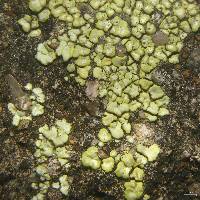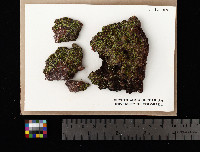
Consortium of Lichen Herbaria
- building a Global Consortium of Bryophytes and Lichens as keystones of cryptobiotic communities -
- Home
- Search
- Images
- Species Checklists
- US States: O-Z >
- US National Parks
- Central America
- South America
- US National Parks
- Southern Subpolar Region
|
|
|
|
Family: Acarosporaceae
[Lecanora chrysops Tuck.] |
Nash, T.H., Ryan, B.D., Gries, C., Bungartz, F., (eds.) 2007. Lichen Flora of the Greater Sonoran Desert Region. Vol 3. Lectotype: USA: South Carolina: Aiken. H.W. Ravenel 424 (FH!) Thallus: areolate, dispersed or contiguous; overall forming patches up to 5 cm wide areoles: irregular or round, rarely lobed but with a well-developed rim, 0.5-1 mm in diam., 0.2-0.5 mm thick; rim: ±down-turned , often undulate upper surface: yellow, dull, plane or concave, epruinose, or paler and pruinose especially toward center upper cortex: paraplectenchymatous, 20-40 µm thick; syncortex: not apparent; eucortex: upper half yellow, lower half hyaline medulla: white, prosoplectenchymatous lower surface: narrow beneath well-developed rim, dark attachment: broad Apothecia: 1(-4) per areole disc: red, rough, less than 0.5 mm wide parathecium: rather indistinct epihymenium: yellowish brown, 10-15 µm thick hymenium: pale yellow above, hyaline below, 90-110 µm tall; paraphyses: 1-2 µm wide at base, apices slightly expanded, usually reddish brown subhymenium: indistinct; hypothecium: indistinct asci: clavate, 60-90 x 15-20 µm, 100+ -spored ascospores: hyaline, simple, usually narrowly ellipsoid, but occasionally with some broadr spores, 4-6 x 1.9-2.2(-2.5) µm Pycnidia: globose, 60-100 µm wide (Magnusson 1929) conidia: bacilliform, c. 2 x c. 0.6 µm (Magnusson 1929) Spot tests: UV+ orange (weak), all spot tests negative Secondary metabolites: rhizocarpic acid and sometimes epanorin. Substrate and ecology: on acidic and volcanic rocks and soil World distribution: Mexico, North America (from the Rockies and Texas east to Kansas, Louisiana and the Ozarks), Central America (Costa Rica, El Salvador), South America (Brazil, Columbia, Ecuador) Sonoran distribution: Arizona (known from a single collection from Tonto National Forest at 525 meters, Schroeder, R. (= Schoeninger, R. 454, ASU!) Notes: Its well-developed rim, broad attachment, and generally narrowly ellipsoid spores distinguish A. chrysops from the more common Sonoran species A. socialis. Many specimens have a whitened center, as does A. affinis. The species can be confused with young areoles of A. affinis or especially in southeastern North America with A. tuckerae, which has a C+ red medulla and can become more robust and squamulose. Acarospora dissipata is a synonym applied to South American specimens and the split in Magnusson's species concepts (hymenium height and whether areoles were contiguous or dispersed) was so narrow that he recognized A. dissipata as occurring in southeastern US and A. chrysops as occurring in South America. |
|
|
|
Powered by Symbiota













































